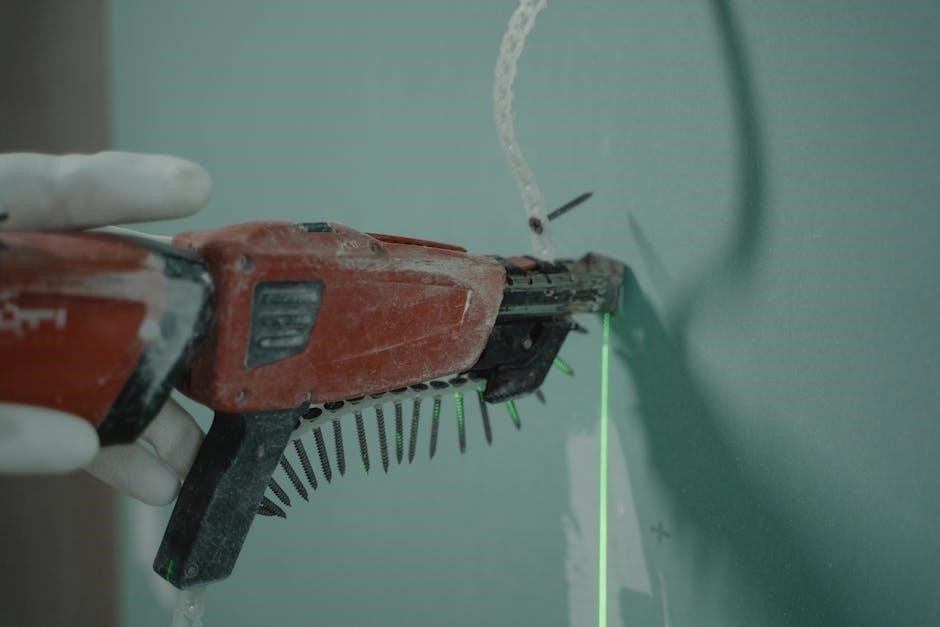Pocket hole screws are essential fasteners in woodworking‚ designed to create strong‚ invisible joints by drilling angled holes. They prevent wood splitting and ensure durable connections‚ making them ideal for various projects.
1.1 What Are Pocket Hole Screws?
Pocket hole screws‚ also known as confirmat screws‚ are specialty fasteners designed for joining wood. They feature a self-piloting tip and coarse or fine threads to prevent splitting. Used with a pocket hole jig‚ they create strong‚ invisible joints by drilling angled holes in wood‚ allowing screws to pull pieces together securely. Available in various lengths‚ diameters‚ and coatings‚ they suit different woodworking projects‚ from furniture to outdoor constructions‚ ensuring durability and stability in both softwoods and hardwoods. Their unique design makes them indispensable for creating professional-grade joints efficiently.
1.2 Importance of Pocket Hole Screws in Woodworking
Pocket hole screws are vital in woodworking for creating strong‚ durable joints without visible fasteners. They prevent wood splitting‚ especially in softwoods‚ and provide excellent holding power. Their angled design allows for flush surfaces‚ ideal for furniture‚ cabinets‚ and outdoor structures. Unlike traditional methods‚ they enable quick assembly and precise alignment‚ making them a preferred choice for both professionals and hobbyists. Their versatility and reliability ensure lasting results‚ enhancing the overall quality and appearance of woodworking projects while simplifying the joinery process.
Types of Pocket Hole Screws
Pocket hole screws vary by thread type‚ head style‚ and coating. Coarse-thread screws are best for softwoods‚ while fine-thread screws suit hardwoods. Pan-head and flat-head options offer different uses‚ with coatings like zinc or epoxy for indoor or outdoor durability. They also come in various lengths and diameters‚ ensuring versatility for diverse woodworking projects.
2.1 Coarse-Thread vs. Fine-Thread Screws
Coarse-thread screws are designed for softwoods like pine or fir‚ offering superior grip and reduced splitting. Fine-thread screws are ideal for hardwoods‚ minimizing wood splintering and ensuring a tighter fit. Coarse-thread screws have deeper grooves‚ providing better hold in softer materials‚ while fine-thread screws have shallower grooves‚ making them less likely to split dense woods. Choosing the right thread type depends on the wood density and project requirements. Using a selection chart can help determine the optimal screw for your material thickness and type‚ ensuring strong and durable joints in your woodworking projects.
2.2 Pan-Head vs. Flat-Head Screws
Pan-head screws are ideal for general use and thicker materials‚ offering a strong hold. Flat-head screws are better suited for thinner materials‚ allowing the screw head to sit flush. Pan-head screws are recommended for 1.5” material thickness‚ while flat-head screws work best for 1.3” or less. The choice depends on the material thickness and desired finish‚ ensuring optimal performance and appearance in woodworking projects. Proper selection enhances joint strength and prevents splitting‚ making it crucial for achieving professional results in pocket hole joinery.
2.3 Indoor vs. Outdoor Pocket Hole Screws
Indoor pocket hole screws are designed for interior projects‚ typically made of steel with zinc or galvanized coatings. Outdoor screws are coated with weather-resistant materials‚ such as stainless steel or epoxy‚ to withstand moisture. When working outdoors‚ choose screws resistant to rust and corrosion for durability. For indoor projects‚ standard coatings suffice. Proper selection ensures long-lasting joints‚ whether it’s furniture making or deck building. Always match screw type to project location to maintain strength and avoid material degradation over time.
Choosing the Right Pocket Hole Screw
Selecting the right screw involves considering wood type‚ thickness‚ and project location. Coarse-thread screws suit softwoods‚ while fine-thread screws are ideal for hardwoods. Ensure proper length and coating for durability.
3.1 Understanding Screw Length and Material Thickness
Choosing the correct screw length is crucial for strong joints. Measure the material thickness and select screws that penetrate at least halfway into the second piece without over-extending. For 1-inch thick wood‚ use 1-1/4-inch screws. Ensure screws are long enough to secure the joint but not so long they protrude. Proper alignment and material compatibility ensure durability and prevent splitting‚ especially in softer woods like pine or plywood. Always refer to a screw length chart for accurate selection based on your project’s specific needs.
3.2 Screw Diameter: When to Use Larger or Smaller Screws
Screw diameter depends on the project’s requirements and wood type. Larger screws provide greater strength in thicker materials‚ while smaller screws are ideal for thinner woods to avoid splitting. Coarse-thread screws‚ with larger diameters‚ are best for softwoods like pine or plywood‚ ensuring strong hold. Fine-thread screws‚ with smaller diameters‚ suit hardwoods to prevent splitting. Pan-head screws are recommended for thicker materials‚ while flat-head screws work better for thinner woods. Always match the screw diameter to the wood’s density and thickness for optimal results and durability in your woodworking projects.
3.3 Coatings and Finishes for Different Applications
Pocket hole screws come in various coatings and finishes to suit different projects. For indoor use‚ zinc-coated or stainless steel screws are durable and resist corrosion. Outdoor projects require weather-resistant options like Blue-Kote or galvanized coatings to withstand moisture and humidity. Hardwood applications benefit from fine-thread screws with wax coatings for smoother insertion. Pan-head screws are ideal for thicker materials‚ while flat-head screws are better for thinner woods. Always choose a finish that matches your project’s environment and material type to ensure long-lasting strength and protection.

How to Use a Pocket Hole Jig
Set up the jig‚ clamp the workpiece‚ and drill pilot and pocket holes at a 15-degree angle. Drive screws securely for strong‚ hidden joints in your projects.
4.1 Setting Up the Jig for Accurate Drilling
Begin by attaching the pocket hole jig to your workbench for stability. Adjust the drill guides according to your material thickness‚ ensuring proper alignment. Clamp the jig firmly to the workpiece‚ ensuring it sits flush for accurate drilling. Set the depth collar on the drill bit to match the screw length‚ ensuring consistent hole depth. Double-check all adjustments before drilling to avoid errors. Proper setup ensures precise pilot and pocket holes‚ critical for strong joints and professional results.
4.2 Drilling Pilot Holes and Pocket Holes
Start by clamping the workpiece securely to the jig. Use the drill bit with a depth collar to create the pilot hole first‚ ensuring proper alignment. Next‚ drill the pocket hole at the correct angle‚ guided by the jig. Maintain steady pressure to avoid bit wandering. The pilot hole ensures the screw aligns correctly‚ while the pocket hole provides the necessary angle for a strong joint; Always use the recommended drill bit size for your screws to prevent errors and ensure precise results.
4.3 Clamping Techniques for Secure Joints
Proper clamping is crucial for creating secure joints with pocket hole screws. Use high-quality clamps or the jig’s built-in clamping system to hold the workpiece firmly in place. Ensure the material is stable and alignment is accurate before drilling. Apply even pressure to prevent movement during the drilling and screwing process. For larger projects‚ additional clamps can be used to maintain stability. Always clamp the workpiece flat to the jig or work surface to avoid uneven joints and ensure the screws seat properly for maximum strength and durability.
Best Practices for Pocket Hole Joinery
Become proficient in pocket hole joinery by ensuring precise screw placement‚ avoiding common drilling mistakes‚ and using techniques to tighten screws without splitting the wood for professional results.
5.1 Proper Screw Placement for Maximum Strength
Proper screw placement is critical for ensuring strong joints. Always position screws away from edges to prevent splitting and align them with the wood’s edge or face grain for optimal hold. Using a jig guarantees accurate placement‚ while maintaining consistent screw depth ensures even pressure distribution. Avoid over-tightening‚ as this can weaken the joint. By carefully positioning each screw‚ you maximize joint integrity and achieve professional-quality results in your woodworking projects.
5.2 Avoiding Common Mistakes in Pocket Hole Drilling
Common mistakes in pocket hole drilling include incorrect drill bit alignment‚ insufficient clamping‚ and improper screw depth. To avoid these‚ always use a jig for precision and ensure the workpiece is securely clamped. Drilling pilot holes correctly prevents wood from splitting. Over-drilling can weaken the joint‚ so adhere to recommended depths. Additionally‚ using the wrong screw type for the material thickness can lead to weak connections. By following these guidelines‚ you can avoid errors and achieve strong‚ durable joints in your projects.
5.3 Tips for Tightening Screws Without Splitting Wood
Tightening screws without splitting wood requires careful technique. Use a screwdriver with a firm grip and apply steady‚ consistent pressure. Avoid over-tightening‚ as this can cause wood fibers to tear. Pre-drilling pilot holes ensures screws enter smoothly. Using the correct screw type for your wood thickness and material is crucial. For added stability‚ apply wood glue before assembling. Clamp the pieces firmly while tightening to distribute pressure evenly. By following these steps‚ you can secure your joints without damaging the wood‚ ensuring professional-looking results every time.

Applications of Pocket Hole Screws
Pocket hole screws are versatile‚ ideal for furniture making‚ cabinet construction‚ and outdoor projects like decks and fences. They excel in joining thick or hardwoods‚ ensuring durability and strength.
6.1 Furniture Making and Cabinet Construction
Pocket hole screws are a cornerstone in furniture making and cabinet construction‚ offering strong‚ hidden joints. They are particularly useful for building tables‚ chairs‚ and shelving units‚ as they provide excellent structural integrity without visible fasteners. In cabinetry‚ they allow for seamless assembly of drawer boxes‚ cabinet frames‚ and doors. The ability to drill angled holes ensures that the screws pull the wood tightly together‚ creating a rigid and durable framework. This method is especially advantageous for DIY enthusiasts and professionals alike‚ streamlining the assembly process and ensuring professional-grade results. Additionally‚ the use of pocket screws in furniture making often eliminates the need for clamps during assembly‚ saving time and effort. Their versatility makes them a go-to choice for both modern and traditional woodworking projects‚ ensuring that the final pieces are both functional and aesthetically pleasing. Moreover‚ the hidden nature of the screws allows the natural beauty of the wood to remain the focal point‚ enhancing the overall appearance of the finished product. Whether it’s a custom dining table or a set of kitchen cabinets‚ pocket hole screws deliver the strength and precision needed to bring any furniture-making vision to life.
6;2 Outdoor Projects: Decks‚ Fences‚ and More
Pocket hole screws are ideal for outdoor projects like decks‚ fences‚ and planters‚ offering durability and strength. Coarse-thread screws are best for softwoods commonly used outdoors‚ while weather-resistant coatings like galvanized or stainless steel protect against moisture and UV exposure. These screws ensure secure joints in demanding conditions‚ making them perfect for constructing sturdy outdoor structures. Whether building a deck‚ fence‚ or pergola‚ pocket hole screws provide long-lasting performance and low maintenance‚ ensuring your outdoor projects withstand the elements for years to come. Their reliability makes them a top choice for exterior woodworking applications.
6.3 Joining Thick or Hardwoods with Pocket Screws
Pocket hole screws are highly effective for joining thick or hardwoods‚ as they provide strong‚ reliable connections. For hardwoods like oak or maple‚ fine-thread screws are recommended due to their superior holding power in dense materials. When working with thick wood‚ ensure screws are long enough to penetrate adequately without causing splits; Proper jig setup and high-quality screws are crucial for secure joints. This method ensures stability and durability‚ making it ideal for heavy-duty woodworking projects involving thick or hardwood materials. Always choose screws suited to your wood type for optimal results.

Pocket Hole Screw Guide for Beginners
Mastering pocket hole screws starts with understanding their basics. Learn how to choose the right screws‚ set up your jig‚ and clamp materials for professional results.
7.1 Essential Tools You Need to Get Started
To begin with pocket hole joinery‚ you’ll need a few key tools. First‚ a pocket hole jig is essential for drilling accurate holes. This jig typically includes drill guides and clamps to secure your workpiece. Next‚ you’ll need a drill bit specifically designed for creating pilot and pocket holes. Additionally‚ a set of pocket hole screws in various lengths and types is necessary‚ depending on your project’s requirements. A clamp will help hold your pieces together while drilling and screwing. Lastly‚ a depth gauge ensures your screws are properly seated without over-drilling. These tools will set you up for success in your woodworking projects.
7.2 Step-by-Step Guide to Your First Pocket Hole Project
Starting your first pocket hole project? Follow these simple steps. Begin by assembling your materials‚ including wood pieces‚ a pocket hole jig‚ drill‚ and screws. Set up your jig according to the manufacturer’s instructions‚ ensuring it’s clamped securely to your workpiece. Next‚ drill pilot holes where you want the screws to go‚ then use the jig to create the pocket holes. Align the pieces you’re joining and clamp them together. Finally‚ drive the screws into place‚ ensuring they’re snug but not over-tightened. With these steps‚ you’ll achieve strong‚ hidden joints for your project.
7.3 Common Terms and Terminology Explained
Understanding key terms is crucial for mastering pocket hole joinery. A pocket hole is an angled hole drilled in wood to hide screws. The jig is a tool that guides the drill for precise hole placement. Coarse-thread screws are best for softwoods‚ while fine-thread screws suit hardwoods. Pilot holes prevent splitting and guide screw placement. Material thickness determines screw length. Grasping these terms ensures proper technique and successful projects‚ helping you avoid common mistakes and achieve professional results in your woodworking endeavors.

Advanced Tips and Tricks
Use multiple screws for extra stability‚ angle screws for better load-bearing‚ and reinforce joints with wood glue for unmatched durability in your woodworking projects.
8.1 Using Multiple Screws for Extra Stability
Using multiple pocket hole screws can significantly enhance the stability of your joints‚ especially in heavier or load-bearing projects. By distributing the weight across several screws‚ you minimize the risk of joint failure. For wider materials or thicker wood‚ consider adding screws at intervals to ensure even stress distribution. This method is particularly effective in furniture making and large-scale constructions‚ where durability is crucial. Always consult a screw selection chart to match the number and size of screws to your project’s requirements for optimal results.
8.2 Reinforcing Joints with Wood Glue
Reinforcing joints with wood glue enhances the strength and durability of pocket hole connections. Apply a small amount of glue to the pilot holes and wood surfaces before inserting the screws. This creates a strong bond between the materials‚ reducing the risk of shifting or loosening over time. The glue dries quickly‚ so clamp the joint immediately after assembly. Combining wood glue with pocket hole screws ensures a rigid and long-lasting connection‚ ideal for both indoor and outdoor woodworking projects.
8.3 Angling Screws for Better Load-Bearing Capacity
Angling screws in pocket hole joints can significantly improve load-bearing capacity by distributing weight more evenly. The 15-degree angle recommended for pocket hole screws ensures better grip and reduces the risk of the joint shifting under stress. This technique is particularly effective for hardwoods or thicker materials‚ where straight screws might fail to provide adequate support. By angling the screws‚ you create a stronger mechanical bond‚ enhancing the overall durability of the joint. This method is especially useful for heavy-duty applications‚ ensuring your project remains stable and secure over time.
Pocket Hole Screw Jigs and Accessories
Pocket hole screw jigs and accessories are designed to simplify and enhance the accuracy of pocket hole drilling. They include durable aluminum alloy jigs with adjustable drill guides‚ clamping systems‚ and specialized drill bits‚ ensuring precise and efficient hole placement for strong joints.
9.1 Types of Jigs Available on the Market
Various pocket hole jigs cater to different needs‚ from basic to advanced woodworking. Basic jigs offer essential features for drilling pocket holes‚ while premium models include adjustable drill guides and clamping systems. Multi-hole jigs allow for drilling multiple holes at once‚ saving time. Jigs are often made of durable materials like aluminum alloy‚ ensuring longevity. They also come with features like 15-degree hole locators for precise drilling. These tools are versatile‚ accommodating materials from 1/2″ to 1 1/2″ thick‚ making them suitable for a wide range of projects and wood types.
9.2 Must-Have Accessories for Pocket Hole Work
Essential accessories enhance the efficiency and precision of pocket hole projects. A sturdy clamp ensures secure workpiece holding‚ preventing movement during drilling. High-quality drill bits‚ designed for pocket hole jigs‚ maintain accuracy and longevity. Depth guides and stop collars help control drill depth‚ avoiding over-drilling. Screwdriver bits and drivers are crucial for securely fastening screws. Additionally‚ thickness charts and material guides aid in selecting the right screw length and type‚ ensuring optimal joint strength. These tools collectively streamline the process‚ making projects easier and more professional.
9.3 Maintaining and Calibrating Your Jig
Regular maintenance and calibration are crucial for ensuring your pocket hole jig performs accurately. Clean the jig frequently to remove dust and debris that may affect alignment. Check the drill guides for proper alignment and tighten any loose parts. Lubricate moving components to maintain smooth operation. Calibrate the jig by following the manufacturer’s instructions‚ ensuring the drill bit aligns correctly with the guides. Store the jig in a dry place to prevent rust and damage. Proper upkeep ensures consistent results and extends the jig’s lifespan for precise pocket hole drilling every time.

Safety Precautions
Always wear safety glasses and gloves when drilling. Keep hands clear of the drill bit and use clamps to secure workpieces. Avoid loose clothing and ensure a clear workspace. Follow power tool guidelines to prevent accidents and maintain control during operation.
10.1 Protecting Yourself While Drilling
Protecting yourself while drilling is crucial to avoid injuries. Always wear safety glasses to shield your eyes from debris. Ensure loose clothing or long hair is tied back to prevent entanglement with tools. Use a dust mask if working with materials that generate dust. Keep your hands clear of the drill bit at all times. Properly secure the workpiece using clamps to maintain control and prevent slipping. Maintain a firm grip on the drill and avoid overreaching. Ensure the workspace is well-lit and free from obstructions. Familiarize yourself with the tool’s operation and follow the manufacturer’s guidelines. Regularly inspect drill bits for damage or wear to prevent accidents. By adhering to these safety measures‚ you can ensure a safe and efficient drilling process for your pocket hole projects.
10.2 Handling Screws Safely
Handling screws safely is essential to prevent accidents and ensure proper usage. Always avoid over-tightening‚ as this can strip screw holes or damage surrounding material. Use screwdrivers or drills with appropriate torque settings to prevent slippage. Keep screws organized in a secure container to avoid misplacement or accidental ingestion. When driving screws‚ ensure the workpiece is clamped firmly to prevent movement. Wear gloves to improve grip and protect your hands from sharp edges. Never leave loose screws unattended‚ as they can cause tripping hazards. Regularly inspect screws for damage or rust before use. By following these practices‚ you can handle screws safely and efficiently.
10.3 Workshop Safety Tips
Maintaining a safe workshop environment is crucial for successful projects. Always wear protective gear‚ including safety glasses and a dust mask‚ when drilling or sanding. Keep loose clothing and long hair tied back to avoid entanglement with tools. Ensure the workshop is well-ventilated to prevent inhaling dust and fumes. Regularly inspect tools for damage and ensure they are properly calibrated. Keep floors clear of clutter to prevent tripping. Store pocket hole screws and tools in designated areas to avoid misplacement. Never leave power tools unattended or within reach of children. Adhering to these safety practices ensures a secure and productive workspace.
Troubleshooting Common Issues
- Stripped screw holes can be fixed with wood filler plugs or by drilling slightly deeper;
- Split wood can be reinforced with wood glue and clamps before re-drilling.
- Adjust screw depth to ensure proper fit and avoid over-tightening‚ which may damage the material.
11.1 Fixing Stripped Screw Holes
If a screw hole becomes stripped‚ it can compromise the joint’s strength. To fix this‚ fill the hole with wood filler or a wooden plug‚ allowing it to dry completely. Once dry‚ sand the area smooth and re-drill the pilot hole slightly offset from the original. Use a screw of the same size or slightly larger for a secure fit. Ensure the wood is clamped tightly during re-drilling to prevent further damage. This method strengthens the joint and restores its durability‚ ensuring your project remains sturdy and professional-looking.
11.2 Dealing with Split Wood
If wood splits while drilling or driving screws‚ stop immediately to assess the damage. For minor splits‚ apply wood glue and clamp the piece tightly‚ allowing it to dry completely. For larger splits‚ consider reinforcing the area with a wooden shim or dowel. To prevent splitting in the future‚ ensure pilot holes are drilled correctly and screws are not overtightened. Using the right screw type and size for your wood thickness can also minimize the risk of splitting‚ ensuring stronger and more durable joints in your woodworking projects.
11.3 Adjusting Screw Depth for Proper Fit
Adjusting screw depth is crucial for ensuring a proper fit and preventing damage. Use the stop collar on your drill bit to control the depth of the pilot hole. If the screw sits too deeply‚ the joint may weaken; if it’s too shallow‚ the screw may not hold securely. To fix this‚ measure the material thickness and refer to a screw depth guide or chart. Proper adjustment ensures the screw head sits flush‚ providing optimal strength and a clean finish for your pocket hole joints. This step is essential for achieving professional-looking results in woodworking projects.
Pocket hole screws are a versatile and essential tool in woodworking‚ offering strong‚ invisible joints. This guide provided key insights for selecting and using them effectively. Mastery leads to professional results‚ encouraging continuous practice and experimentation for perfect projects.
12.1 Summary of Key Takeaways
Pocket hole screws are a cornerstone of modern woodworking‚ enabling strong and invisible joints. Key points include selecting the right screw based on wood type and thickness‚ using a jig for precision‚ and following best practices to avoid common mistakes. Proper techniques‚ such as angling screws and using wood glue‚ enhance joint strength. Regular maintenance of tools and adherence to safety guidelines ensure optimal results. With practice‚ anyone can master pocket hole joinery‚ achieving professional-grade projects efficiently and effectively.
12.2 Encouragement to Practice and Experiment
Don’t hesitate to practice and experiment with pocket hole joinery—it’s a skill that improves with hands-on experience. Start with simple projects to build confidence‚ then gradually tackle more complex designs. Experiment with different screw types‚ lengths‚ and techniques to understand their effects on joint strength. Remember‚ every project is an opportunity to refine your craft. Embrace mistakes as learning moments and keep exploring new ways to enhance your pocket hole creations. With patience and practice‚ you’ll master this versatile joinery method and unlock endless woodworking possibilities.
12.3 Final Thoughts on Pocket Hole Screws
Pocket hole screws are a game-changer in woodworking‚ offering strength‚ versatility‚ and ease of use. Whether you’re a beginner or an experienced craftsman‚ these screws provide reliable results. Their ability to create invisible‚ durable joints makes them ideal for both functional and decorative projects. By selecting the right screws and mastering the techniques outlined in this guide‚ you’ll achieve professional-grade results; Embrace the simplicity and efficiency of pocket hole joinery to bring your woodworking visions to life with confidence and precision. Happy building!